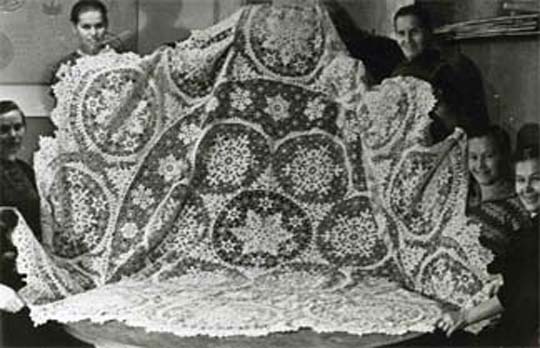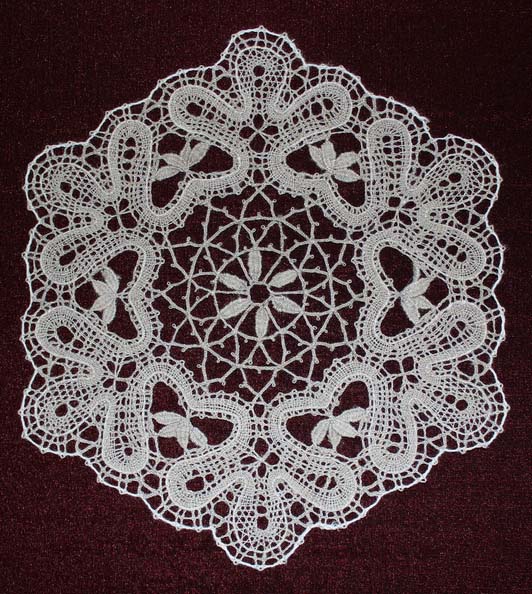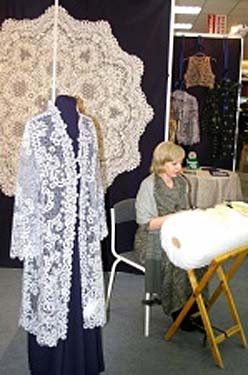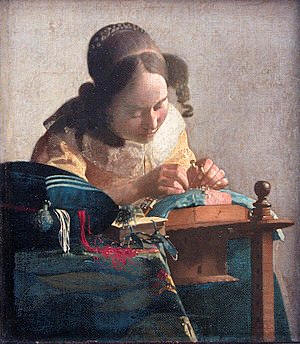![]()
![]()
When in St. Petersburg...

Thought this would get your attention at the very start.
This 1959 photo shows a huge lace covering made by 25 Russian women of the "Snowflake" group in the city of Vologda, NE of Moscow.
The Russian Museum had a special exhibition of their amazing works in a galley with limited access. Photography wasn't allow but I got one legal picture that I'll present below.
A brochure included this information:
"Vologda is north of Moscow about 300 miles. It has a population of 283,000. After starting as a monastery it became a town in 1147. In 1965 the name “Snowflake” was granted to the lace enterprise.
"The creator of “Snowflake” was V. N. Elfena (1930-1998), great Russian artist. She worked in Vologda from 1952, producing a large number outstanding works. She died in June, 1998."
From Wikipedia, http://cultinfo.ru/en/tnk/vologda-lace.php
Vologda lace is a special phenomenon in folk art of the Russian North. Richness and variety of patterns, smoothness of lines, measured rhythm of an ornament, high skills are its artistic peculiarities. Vologda lace is known all over the world, for the long time it personified the glory of the Russian lace.
The distinctive feature of traditional Vologda twin lace is an accurate division of the lace in a pattern and a background. As a result large and smooth forms of the ornament are expressively notable by its continuous line equal in wide along the pattern. In earlier Vologda lace stylized images of birds, a tree of life and other old motifs typical to the ancient embroidery were used as the leading ornament. Today Vologda lace is distinctive by the variety of ornaments, monumentality of forms and prevalence of color motifs.
Vologda craft got a broad fame in Russia and abroad. Talent and skills of Vologda lace designers and makers were marked in many international and domestic exhibitions. Vologda lace today is first of all a lace-making company «Snezhinka» (Snowflake) where skilled lace-makers and experienced designers work, it is a professional college where future lace-makers are taught and these are establishments of subsidiary education where young vologodians are introduced to the history of lace-making and master the grounds of the handicraft. Vologda lace-making company «Snezhinka» is a regular participant of international and Russian exhibitions. The company cooperates with Russian and foreign partners. The important part of the designers activity is making exponents for museums and exhibitions.
From the web:
 |
 |

What particularly struck me in the exhibit were some garments made of lace designed to be worn. Lace making in 3D!
I couldn't take any photos, as I said, but I found this one (right) on the web that shows one such garment along with part of a workroom(?) and a worker.
They make "bobbin" lace, meaning a design is drawn on paper; the design is transferred onto a pillow; many pins are placed a key points in the design; thread is woven among the pins; and the product is lifted off the pillow. The threads are wrapped around many finger-sized bobbins and the various threads are crossed among the pins to form the lace object. Carole speculates one as large as at the top was made in many (25?) doily-sized pieces and then linked together to form one large product.
An illustration (below) of a bobbin lace maker at work on a small piece was drawn by Vermeer in 1670. Perhaps this is Vermeer's wife? It's in Paris' Louvre. It's only 8x9 inches in size. But I digress!

Now for the lace I was allowed to photograph in the Russian Museum. At an entrance to the exhibit room there was a large table cloth (8 feet across?) hanging over the doorway. Photos were allowed in this hallway, so I thought perhaps I could take the picture of this one.
A woman sat at a desk beside the entrance. I used sign language, pointing from the camera to the lace, to ask for permission. Politely denied.
I went to the other side of the hall and sat down to just take in all the details of the lace. Soon the woman came over and somehow let me know I could photograph it after all. I must have impressed her with intense interest.
On this trip I used a small camcorder and, for fees, "shot" the interior of the Hermitage and other buildings of interest. It took excellent videos that I could feed into my computer and generate still photos, and has an impressive zoom lens. Below are three frames from the video.
 |
 |
 |
| This is the whole piece of lace, which I estimated to be 8 feet across. | I zoomed onto the center "star" for a look at some of the details. | I also zoomed onto an off-center location near the edge. |
I enjoyed seeing such amazing lace, but if you see that I've made a mistake in my text on something I really know nothing about, please let me know.
Warning: Do NOT get me started on Russian ballet!
Just for Fun
What do you do for fun on a free weekend in St. Petersburg, Russia?

In Nov. 1998 one of my answers was to go to the Russian Museum http://en.rusmuseum.ru/ .
I'd been there before and enjoyed the Russian paintings and other art objects more than those in the Hermitage (most famous for its palatial architecture). There are always new things to see and enjoy with each visit to a good museum.
An all-wood Russian church finished in 1050 AD.


SALINA HIGH SCHOOL
CLASS OF '57